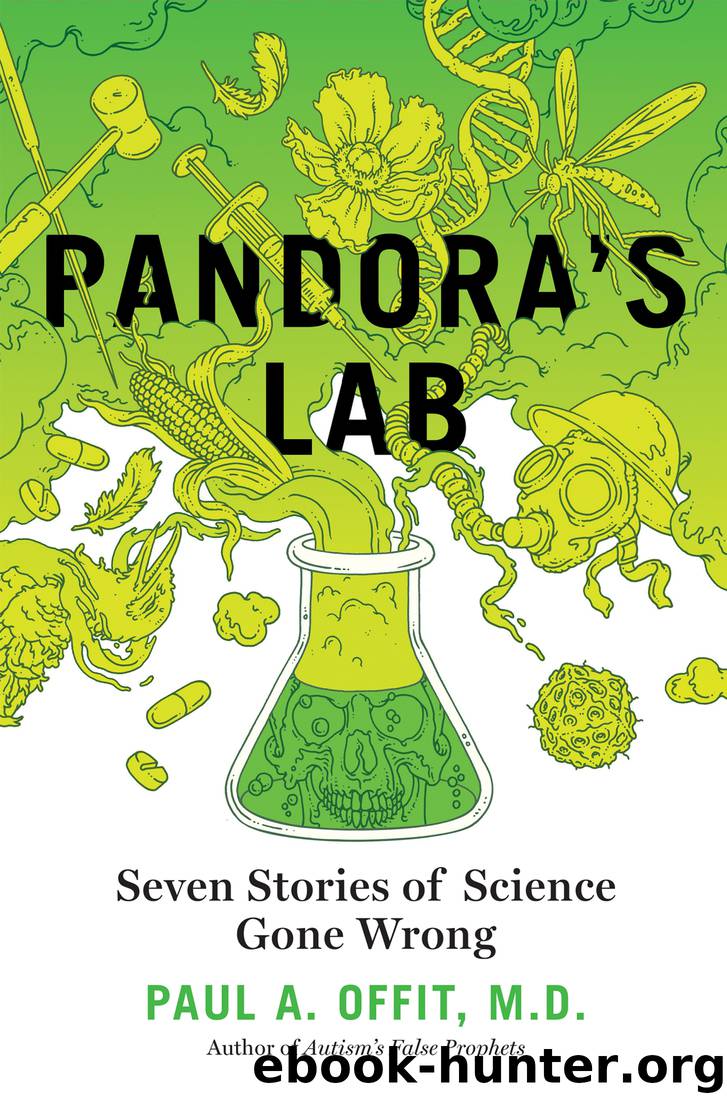Pandora's Lab by Paul A. Offit

Author:Paul A. Offit
Language: eng
Format: epub, mobi
Publisher: National Geographic Society
Published: 2017-04-03T16:00:00+00:00
CHAPTER 6
THE MOSQUITO LIBERATION FRONT
Hey farmer, farmer
Put away that DDT now
Give me spots on my apples
But leave me the birds and the bees
Please!
—Joni Mitchell, “Big Yellow Taxi”
Olga Huckins was angry. On January 29, 1958, she wrote a letter to the Boston Herald.
The previous summer—in an effort to kill growing numbers of gypsy moths, tent caterpillars, and mosquitoes—state authorities had sprayed DDT over large areas of Pennsylvania, New York, and New England. Huckins, who lived near a bird sanctuary in Duxbury, Massachusetts, was horrified by what happened next. “We picked up three dead [robins] the next morning,” she wrote. “They were birds that had lived close to us, trusted us, and built their nests in our trees year after year…All these birds died horribly and in the same way. Their bills were gaping open, and their splayed claws were drawn up to their breasts in agony.”
Huckins wasn’t alone in her anger. Many residents had written letters, sickened by the aftermath of the spraying. Health officials were unbowed. But Olga Huckins refused to be ignored. She sent a copy of her Boston Herald letter to her friend, Rachel Carson. Four years later, Carson published a book about it. Called Silent Spring, it became an international best seller, alerting the world to the dangers of pesticides, landing Carson on national television programs and in front of congressional hearings, winning praise from people as diverse as President John F. Kennedy, Supreme Court Justice William O. Douglas, and singer-songwriter Joni Mitchell, and making Carson one of the most famous and most influential women in the United States. Unfortunately, Rachel Carson had made one tragic mistake.
—
RACHEL LOUISE CARSON was born on May 27, 1907, in Springdale, Pennsylvania, the third of three children. Her father, Robert, was variously an electrician, an insurance salesman, and a night watchman. Her mother, Maria, gave up teaching to raise the children.
Although Springdale was a hardscrabble town known for its glue factory, drab streets, and blue-collar workers. Maria filled Rachel’s childhood with the wonders of nature. Walking hand in hand through the nearby woods, orchards, and fields, or strolling along the banks of the Allegheny River, Maria described in vivid detail the wealth of life around them. So devoted was Maria to her youngest child that, with the exception of a few years in college, she never left her side. More than anything else, Maria encouraged Rachel to write.
In 1922, when she was 15 years old, Rachel wrote an article for St. Nicholas magazine that offered a glimpse into her future. Accompanied by her dog, Pal, Carson described woods where the “majestic silence [was] interrupted only by the rustling breeze, and the cheery, ‘witch, witchery’ of the Maryland yellow throat.” She lovingly described the music of orioles, bobwhites, cuckoos, and hummingbirds, and a nest “containing four jewel-like eggs.” Carson had found a utopia far from the grimy streets of Springdale. Another world. An Eden. A place where she could immerse herself in the intricacies of nature. A place where the man-made stench of Springdale’s glue factory had faded into the distance.
Download
This site does not store any files on its server. We only index and link to content provided by other sites. Please contact the content providers to delete copyright contents if any and email us, we'll remove relevant links or contents immediately.
Enlightenment Now: The Case for Reason, Science, Humanism, and Progress by Steven Pinker(7232)
A Journey Through Charms and Defence Against the Dark Arts (Harry Potter: A Journey Through…) by Pottermore Publishing(4781)
The Immortal Life of Henrietta Lacks by Rebecca Skloot(4525)
A Journey Through Divination and Astronomy by Publishing Pottermore(4344)
Elon Musk by Ashlee Vance(4028)
Origin Story: A Big History of Everything by David Christian(3648)
COSMOS by Carl Sagan(3554)
Alchemy and Alchemists by C. J. S. Thompson(3449)
Bad Pharma by Ben Goldacre(3355)
Enlightenment Now by Steven Pinker(3338)
Shadow of Night by Deborah Harkness(3302)
Inferior by Angela Saini(3276)
A Mind For Numbers: How to Excel at Math and Science (Even If You Flunked Algebra) by Barbara Oakley(3218)
Origin Story by David Christian(3147)
The Code Book by Simon Singh(3074)
Signature in the Cell: DNA and the Evidence for Intelligent Design by Stephen C. Meyer(3071)
The Elements by Theodore Gray(2998)
A Brief History of Time by Stephen Hawking(2960)
A Journey Through Potions and Herbology (A Journey Through…) by Pottermore Publishing(2828)
